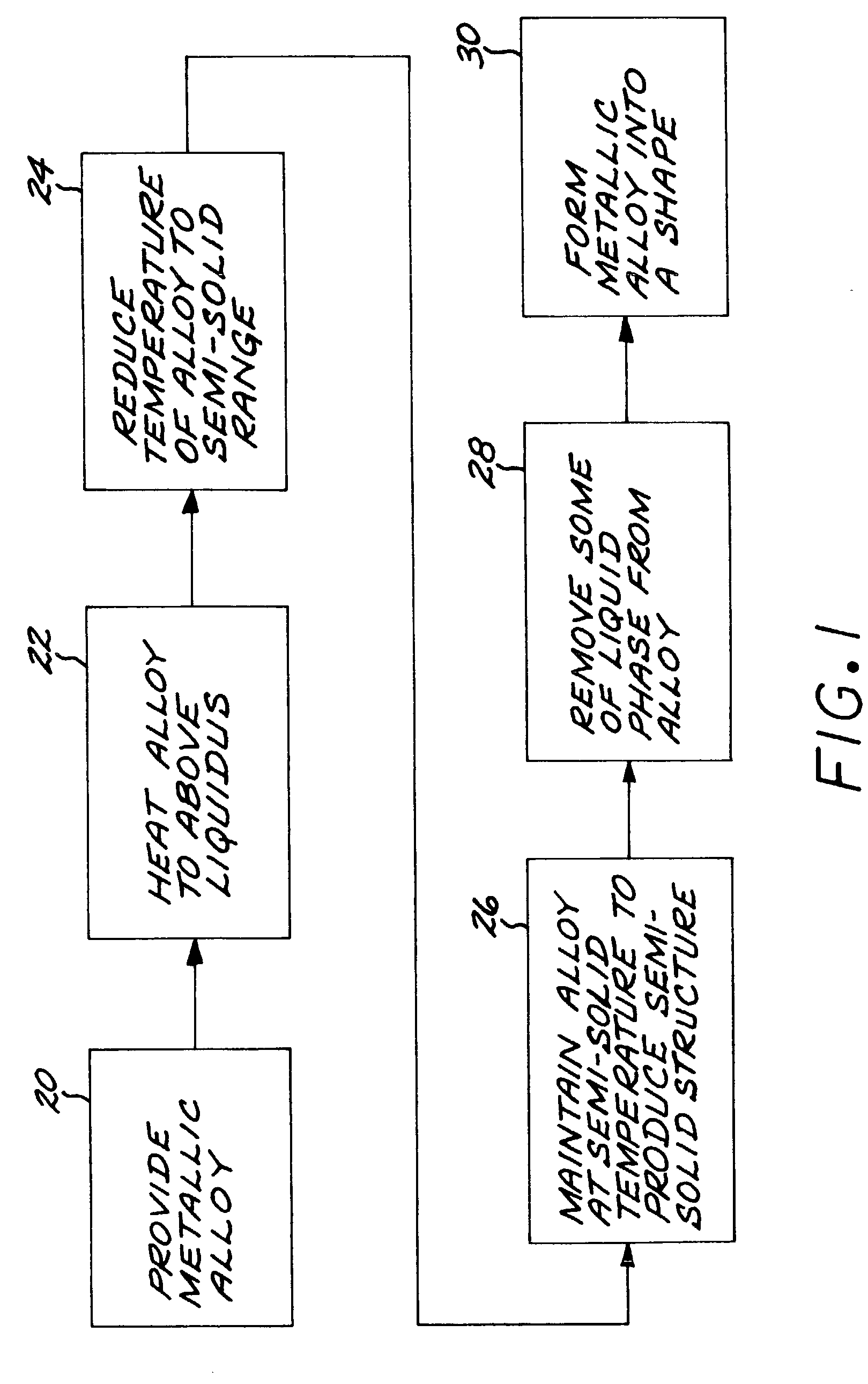Semi-solid concentration processing of metallic alloys
a technology of metallic alloys and concentrations, applied in the direction of metal founding, substation equipment, chemistry apparatus and processes, etc., can solve the problems of many alloys excluded from practical commercial semi-solid processing, high degree of control is not possible, and many commercial semi-solid casting operations are not practical, so as to improve the quality of the final cast product, the effect of low solid variation and high quality
- Summary
- Abstract
- Description
- Claims
- Application Information
AI Technical Summary
Benefits of technology
Problems solved by technology
Method used
Image
Examples
example 1
[0048]Using the apparatus and procedure described above, a semi-solid version of A356 alloy was produced. About 2.8 kilograms of A356 alloy at 660° C. was transferred to a crucible at room temperature, 25° C. (About 0.01 percent titanium grain refiner was added to the A356 alloy as a 5:1 titanium:boron grain refiner rod.) The crucible had an inside diameter of 3.5 inches and a length of 10 inches. The crucible was made of 16 gauge steel tube and weighed 956 grams. The metal was swirled in the crucible for 60 seconds, and then the removable closure was removed to allow the liquid to drain for 45 seconds. The freestanding solid product was thereafter removed from the crucible and measured. This test was run three times on three fresh lots of the A356 alloy. Test results for the mass balance are as follows.
[0049]
TABLE 1Mass BalanceWeightTotalWeightWt. productfiltrateYieldWeightpercentTest(grams)(grams)(percent)(grams)solids119798607028394522002810712812453207873074280843
[0050]The chemi...
example 2
[0052]Example 1 was repeated, except that AA6061 alloy (with the same grain refiner addition as described in Example 1) was used and the quantity of alloy was heated to 700° C. before pouring. Test results for the mass balance are as follows.
[0053]
TABLE 3Mass BalanceWt.WeightTotalWeightproductfiltrateYieldWeightpercentTest(grams)(grams)(%)(grams)solids421016407727414352045720742765416220067077287041
[0054]
TABLE 4Composition (Weight Percent)Starting CompositionProductFiltrateTest456456456Si0.510.510.510.450.440.480.730.630.68Mg0.880.900.900.800.810.871.121.031.09Fe0.150.160.150.140.130.150.220.200.21Cu0.230.230.210.210.200.200.300.280.29Ti0.170.180.180.190.200.200.0290.0730.042
[0055]The results of Tables 2 and 4 illustrate the general manner in which the composition of a modified alloy composition may be determined, such that, when processed by the approach described herein and used in the examples, the resulting product has a desired base alloy composition. In Table 2, Test 1, the si...
PUM
| Property | Measurement | Unit |
|---|---|---|
| weight percent | aaaaa | aaaaa |
| diameter | aaaaa | aaaaa |
| opening size | aaaaa | aaaaa |
Abstract
Description
Claims
Application Information
 Login to View More
Login to View More - R&D
- Intellectual Property
- Life Sciences
- Materials
- Tech Scout
- Unparalleled Data Quality
- Higher Quality Content
- 60% Fewer Hallucinations
Browse by: Latest US Patents, China's latest patents, Technical Efficacy Thesaurus, Application Domain, Technology Topic, Popular Technical Reports.
© 2025 PatSnap. All rights reserved.Legal|Privacy policy|Modern Slavery Act Transparency Statement|Sitemap|About US| Contact US: help@patsnap.com



